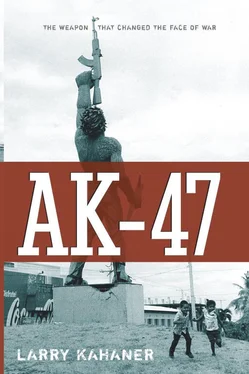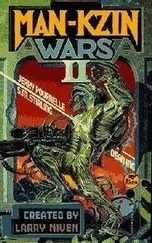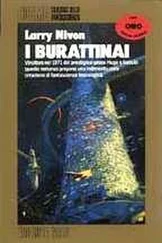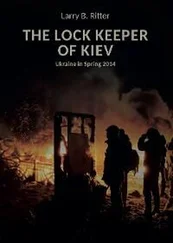Larry Kahaner - AK-47
Здесь есть возможность читать онлайн «Larry Kahaner - AK-47» весь текст электронной книги совершенно бесплатно (целиком полную версию без сокращений). В некоторых случаях можно слушать аудио, скачать через торрент в формате fb2 и присутствует краткое содержание. Город: Hoboken, Год выпуска: 2007, ISBN: 2007, Издательство: John Wiley & Sons, Inc., Жанр: История, military_history, на английском языке. Описание произведения, (предисловие) а так же отзывы посетителей доступны на портале библиотеки ЛибКат.
- Название:AK-47
- Автор:
- Издательство:John Wiley & Sons, Inc.
- Жанр:
- Год:2007
- Город:Hoboken
- ISBN:9780470315668
- Рейтинг книги:3 / 5. Голосов: 1
-
Избранное:Добавить в избранное
- Отзывы:
-
Ваша оценка:
- 60
- 1
- 2
- 3
- 4
- 5
AK-47: краткое содержание, описание и аннотация
Предлагаем к чтению аннотацию, описание, краткое содержание или предисловие (зависит от того, что написал сам автор книги «AK-47»). Если вы не нашли необходимую информацию о книге — напишите в комментариях, мы постараемся отыскать её.
AK-47 — читать онлайн бесплатно полную книгу (весь текст) целиком
Ниже представлен текст книги, разбитый по страницам. Система сохранения места последней прочитанной страницы, позволяет с удобством читать онлайн бесплатно книгу «AK-47», без необходимости каждый раз заново искать на чём Вы остановились. Поставьте закладку, и сможете в любой момент перейти на страницу, на которой закончили чтение.
Интервал:
Закладка:
One of the most important advances in small arms is the concept of rifling, the purpose of which is to stabilize a bullet in flight and improve accuracy. As firearms developed, designers noticed that bullets would wobble once they left the barrel. By adding spiral grooves in the barrel, they could make the bullet spin and be more stable in the air, especially at high speeds. This is the reason why quarterbacks throw a football with as much spin as they can on the ball; it gives a longer and more accurate pass. It’s also why a fast-spinning top has stability while slow-spinning tops wobble and fall over sooner.
Like everything else in arms design, there is a trade-off. Too low a twist rate and the bullet does not stabilize enough. But spinning the bullet too much accentuates even the most miniscule manufacturing defects, causing it to be unstable. Arms designers use complex computer models to find the best twist rate based on barrel length and bullet mass, but field experience usually yields the best data.
And there was another problem adapting the A2 to urban combat. Troops engaged in street fighting in the cities of Somalia years earlier noticed that they spent a great deal of time running in and out of infantry vehicles like Humvees, helicopters, building doors, and passageways. For these kinds of highly mobile situations, their rifles were too long and cumbersome. The quick fix was to outfit soldiers with carbines, rifles with shortened barrels, to make moving around easier. Just prior to their combat roles in Afghanistan and Iraq, soldiers of the 82nd Airborne and 101st Air Assault divisions had their A2s replaced with M-4 carbines, which were shortened versions of the A2. Although the M-4 barrel was only about six inches shorter than that of the A2, the weapon was much easier to handle in confined spaces because it was lighter and had a collapsible stock.
There was still another trade-off, however. The shorter barrel of the carbine gave the bullet a lower velocity compared to the longer-barreled A2. For the M855 bullet to be lethal, it must hit its target at more than 732 meters per second. As with its predecessor, the M193 NATO round penetrated human flesh and spun, causing devastating tissue damage. This only worked at high velocities, however. When fired from a long-barreled A2, the M855 bullet left the barrel at 914 meters per second and entered the target at 732 meters per second at a distance of about 200 meters. With the M-4 carbine, however, the bullet left the barrel at only 790 meters per second and after only 50 meters it had already dropped below the 732 meters per second threshold needed to inflict catastrophic damage. Specially equipped troops have complained that while the weapon was excellent for close-in fighting, it was ineffective at stopping enemy soldiers farther away. The problem was mitigated by the army’s adoption of the MK262 Mod 0 cartridge that fired a slightly heavier 77-grain bullet with a tiny hollow point that fragmented inside the body. GIs reported more kills with this combination.
With more wars being fought in urban environments, the U.S. military eventually had to come up with a new type of weapon that would combine the lightness and shortened length of a carbine with the firepower of the standard M-16. Clearly, the M-4 was an interim, stopgap weapon. Although it was good for close quarters, it overheated on fully automatic fire and became unreliable because of the great stresses placed on its parts. Like Kalashnikov years ago, U.S. military planners had been looking for a new rifle for a new kind of warfare.
A plan for such a rifle, dubbed the XM-8, had been in the works for several years. Prototypes had been tested during 2003 and 2004 and deployment had been hoped for in 2005 but had been held up by the Iraq war and technical issues. Like all new army rifles, political and financial arguments surrounded it. In the case of the XM-8, Congress was reluctant to spend billions to outfit soldiers with new rifles while the war was draining the treasury—not to mention the task of training soldiers on a new weapon on the fly. Adding to the argument was that the new rifle came from Heckler & Koch, a German company, which would mark the first time that a non-U.S. design was used for GIs’ rifles. Some suggested that because Germany had tried to block the U.S. invasion of Iraq, Congress would be remiss in rewarding a German company even though the rifles would be built inside the United States. As the war progressed, the XM-8 was gaining more and more favor with military planners and the soldiers who tested it, but until it was to come online American GIs had to fight the war in Iraq with the weapons they had available, and that included, ironically, AKs. (Many firearms experts, even those inside the military, contend that the XM does nothing significantly better than the current family of small arms. Nevertheless, Defense Department officials want a new weapons system to replace the M-16 series.)
Early reports from the front found GIs using AKs that they had picked up during raids. Unlike Vietnam, where GIs were afraid to use AKs for fear of drawing friendly fire because of the unique sound of the weapon through the dense jungle, where the enemy could be a few feet away and you couldn’t see them, soldiers in Iraq had no such trepidation. In this war, they were rarely close to enemy combatants without knowing it. In many instances, combatants could see each other across open terrain.
One of the first stories to surface was that of the 3rd Battalion, 67th Armor Regiment of the 4th Infantry Division, which operated tanks in the city of Baquba in the summer of 2004. Along with Fallujah, Ramadi, and Samarra, this city of 280,000 people, about thirty miles northeast of Baghdad, and within the so-called Sunni Triangle, saw some of the heaviest ground action of the war.
In general, four-man tank crews were issued two M-4 carbines and four 9mm pistols in the belief that the group would mainly stay inside and fire the tank’s turret-mounted machine gun. But as often occurs, real-life combat is not what Pentagon brass envisioned. While on patrol, the tankers found themselves trying to squeeze their vehicles through streets too narrow to accommodate them and over roads barely wide enough for a person to walk down. They were forced to leave their tanks and patrol on foot. “Normally, an armor battalion fights from tanks,” said Lieutenant Colonel Mark Young. “Well, we are not fighting from our tanks right now.” With each tank group short at least two rifles, the soldiers routinely used AKs, confiscated from raids or checkpoints, and put them to good use. Like their enemy brethren in Vietnam, they appreciated the gun’s simplicity, reliability, and knockdown power, qualities absent from their M-16s and M-4s.
In some instances, even soldiers with the newer M-4s chose the AK because of its fully automatic fire that allowed them to “spray and pray” into hidden enemy positions such as areas of tall grass. They also preferred to have automatic fire inside buildings where the heavier 7.62mm round penetrated wood and thin stucco walls with ease. Soldiers also reported that sometimes it was easier to obtain ammunition for the AKs. During raids they would routinely find hundreds of new rounds in boxes available for the taking.
While some officers had considered prohibiting troops from using the AKs—to comply with army regulations concerning standard firearms—most allowed their soldiers to use them, especially because they would have had no small arms at all beyond their issued pistols.
Soldiers found that unlike their M-16s, the AKs resisted dust and sand from frequent storms that turned the landscape red and then pitch black. During these periods, M-16s clogged easily and did not fire until they were stripped down and cleaned. Troops learned quickly to cover their weapons with plastic wrap or place them in duffel bags. Some fit condoms over the barrel ends, to keep out sand particles that jammed their weapon’s action. The AKs did not require similar handling. The GIs who used them appreciated their performance under adverse desert conditions.
Читать дальшеИнтервал:
Закладка:
Похожие книги на «AK-47»
Представляем Вашему вниманию похожие книги на «AK-47» списком для выбора. Мы отобрали схожую по названию и смыслу литературу в надежде предоставить читателям больше вариантов отыскать новые, интересные, ещё непрочитанные произведения.
Обсуждение, отзывы о книге «AK-47» и просто собственные мнения читателей. Оставьте ваши комментарии, напишите, что Вы думаете о произведении, его смысле или главных героях. Укажите что конкретно понравилось, а что нет, и почему Вы так считаете.











